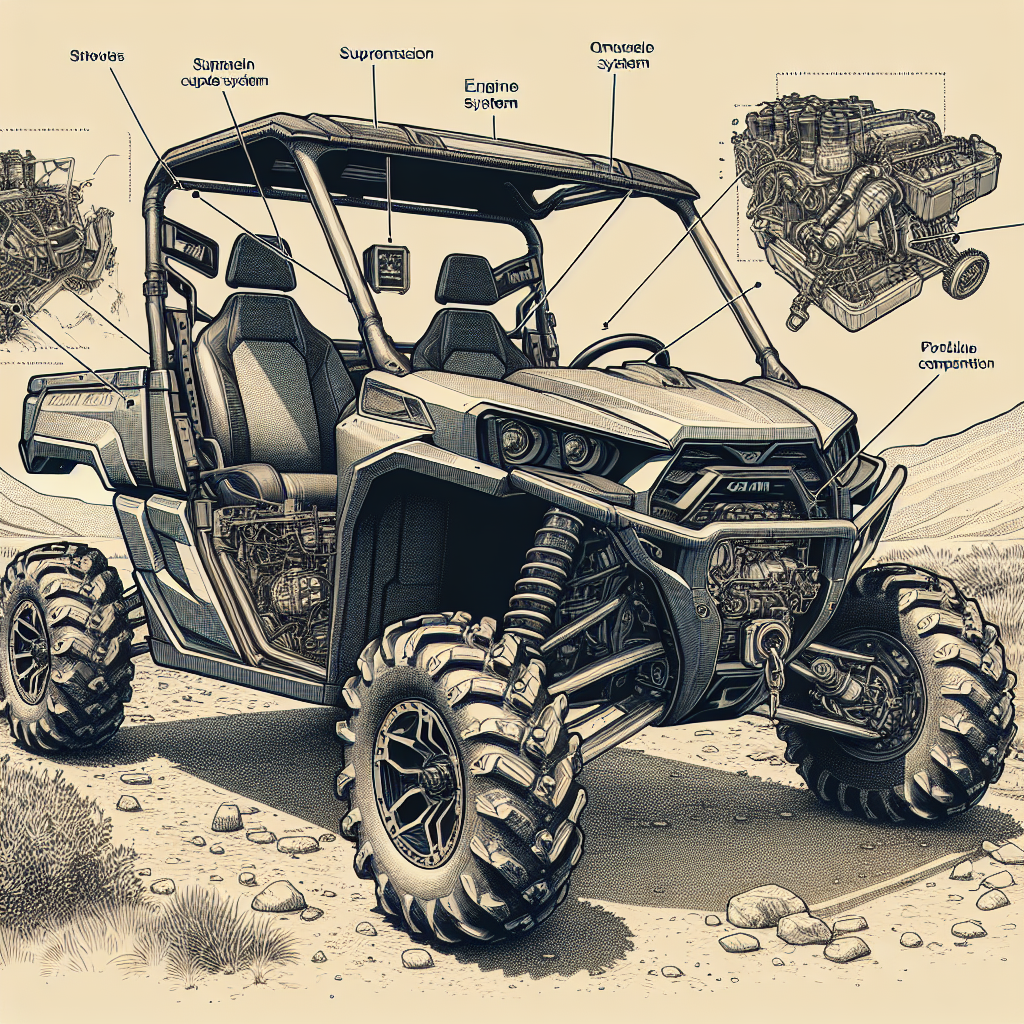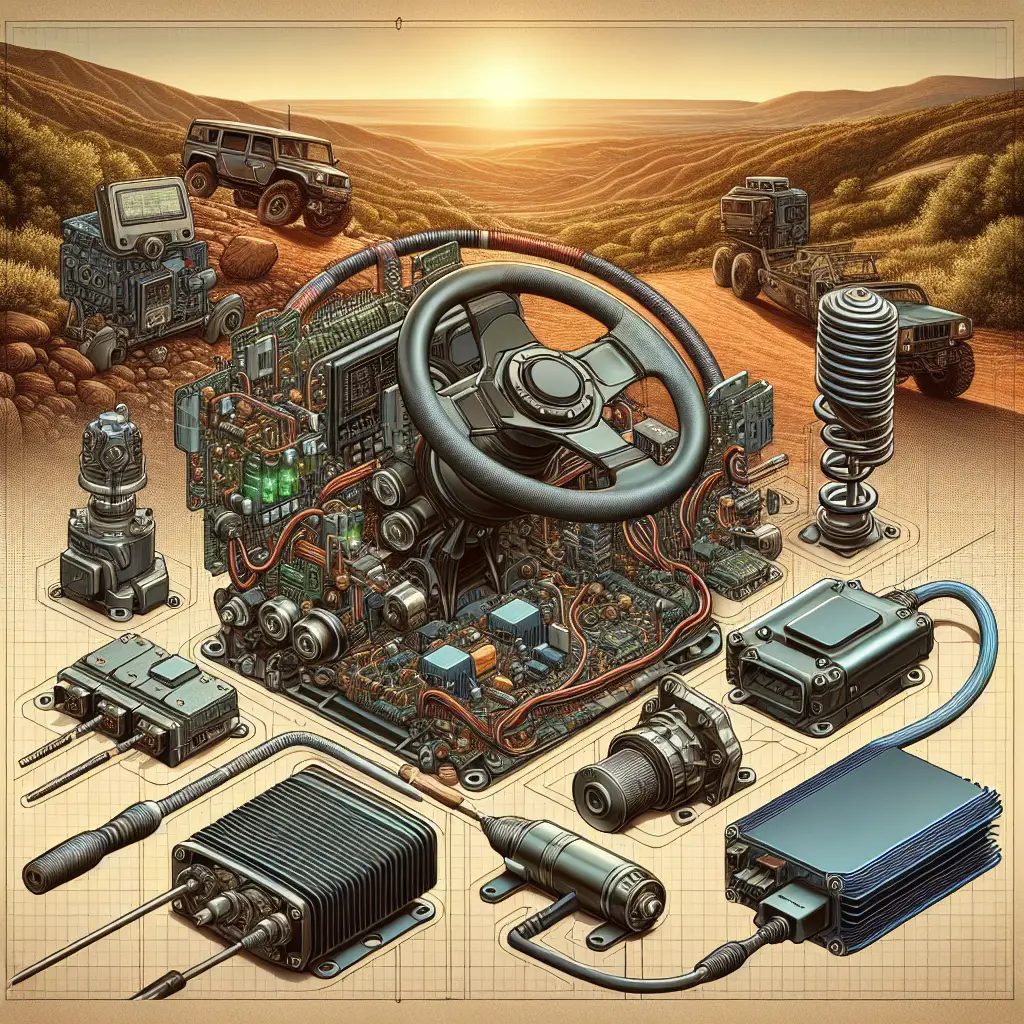When you’re in the market for a utility terrain vehicle (UTV), choices abound, but the Honda Pioneer 1000 and the Polaris Ranger 1000 consistently arise as top options. Each model boasts a loyal following and a suite of features designed to cater to both work and recreational needs. Understanding the key differences between these two popular UTVs will guide you in determining which might best suit your adventures, whether you’re hitting rugged trails or tackling tough jobs.
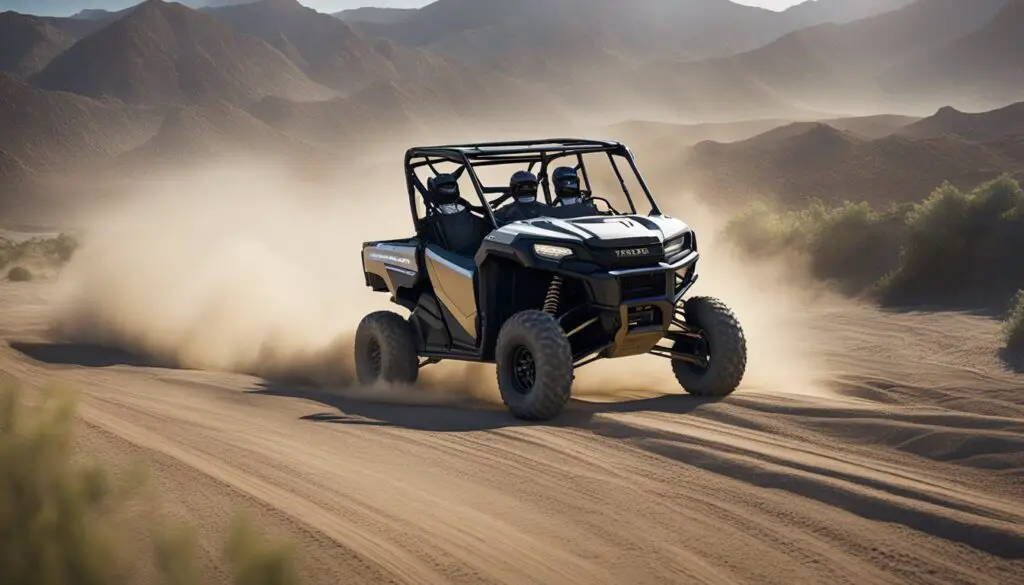
The Honda Pioneer 1000 offers impressive speed and is noted for its direct gear transmission, which can transfer power efficiently. In contrast, the Polaris Ranger 1000 is lauded for its stability and reliability, with a little extra horsepower up its sleeve. It’s this nuanced variety in performance, capability, and design that makes your choice between the two an interesting challenge.
Specs on paper only tell one part of the story, as you’ll likely be interested in how each UTV handles in real-world conditions. Your preference for speed or power, the type of terrain you expect to traverse, and features such as payload and towing capacity will all influence your decision. Take a closer look at each vehicle’s offerings to see which aligns with your expectations, ensuring whichever you choose becomes a trusted companion for your outdoor endeavors.
Honda Pioneer 1000 vs Polaris Ranger 1000 Overview
When choosing between the Honda Pioneer 1000 and the Polaris Ranger 1000, you’re likely considering some of the top UTVs on the market. Let’s break down their key features side by side to help you discern which one might be the better pick for your outdoor adventures.
Performance
The Polaris Ranger 1000 offers a robust 80 hp, providing roughly 11% more power than the Honda Pioneer 1000 which delivers 72 hp. This could be a deciding factor if you’re looking for higher power output.
Efficiency
Both are designed to handle tough terrains, but Polaris owners often highlight the efficiency of their vehicle’s CVT, suggesting it’s more effective in power delivery to the wheels.
Design & Dimensions
| Feature | Honda Pioneer 1000 | Polaris Ranger 1000 |
|---|---|---|
| Overall Dimensions | 116 x 63 x 76 inches | 120 x 62.5 x 76 inches |
| Seating Capacity | Depends on model | Depends on model |
While the external dimensions are similar, each model may offer different seating capacities, so you’ll want to consider whether you need more room for passengers or cargo.
Pricing
The 2023 base model of the Polaris Ranger 1000 has a starting MSRP of $14,799 compared to the $20,899 MSRP for the Honda Pioneer 1000 Trail model. Keep in mind that prices will vary with different trim levels and dealer locations.
Related read: Worst Polaris Ranger Years to Avoid (+The Best)
Design and Comfort

When choosing between the Honda Pioneer 1000 and the Polaris Ranger 1000, you’ll find that both offer features that prioritize design and comfort, but with some differences that might sway your decision.
Seats and Space
In the Honda Pioneer 1000 , you’ll find bench seating designed for multipurpose use. The seating area can accommodate up to three people, with the emphasis on providing enough space for all-day riding comfort. The seats are positioned to give you a commanding view of the trail ahead.
The Polaris Ranger 1000 steps up with bucket seats that deliver a snug and supportive ride during rough terrains. The interior is designed to enhance your comfort with more legroom and an optimized seating position, which makes long journeys less tiring.
Storage and Cargo
Honda Pioneer 1000 boasts a tilt bed with hydraulic assist, with dimensions of 116 x 63 x 76 inches. This cargo bed is versatile and can be very useful for tasks that require a bit of heavy lifting. The Pioneer’s design incorporates multiple storage solutions allowing you to keep your gear organized and secured while on the move.
On the flip side, your Polaris Ranger 1000 not only gives you a sizable cargo box but offers a payload capacity that’s ideal for both work and play. With a slightly larger dimension of 120 x 62.5 x 76 inches, the Ranger serves well when it comes to hauling supplies, thanks to its well-thought-out design that maximizes cargo space without compromising on comfort.
Both UTVs emphasize the integration of storage and cargo features into their design, ensuring that you get the functionality you need without forgoing comfort.
Engine and Performance
In the competition between the Honda Pioneer 1000 and Polaris Ranger 1000, you’ll notice significant differences in their engines and performance characteristics that may inform your decision.
Engine Specs
The Honda Pioneer 1000 is equipped with a 999cc liquid-cooled, 4-stroke, twin-cylinder engine that provides a balance of power and efficiency. In contrast, the Polaris Ranger 1000 also features a 999cc engine, but with different tuning, focusing on work-ready performance.
Transmission and Drivetrain
Honda Pioneer 1000 boasts a Dual Clutch Transmission (DCT) that offers crisp shifts and adaptive performance under various conditions. On the other hand, Polaris Ranger 1000 utilizes an Automatic PVT (Polaris Variable Transmission), which is known for its ability to efficiently transfer power to the wheels with a High-Performance On-Demand True AWD/2WD system, ensuring optimal traction when needed.
Horsepower and Torque
When it comes to horsepower, the Polaris Ranger 1000 edges ahead with an output of approximately 80 hp, which is about 11% more than Honda Pioneer’s 72 hp. Details on torque are not specified, but the higher horsepower of the Ranger indicates a strong engine performance.
Towing and Payload Capacity
As for utility, both vehicles are competent, but your choice may depend on specific needs. The Honda Pioneer 1000 and Polaris Ranger 1000 have considerable towing and payload capacities, but the exact figures can vary based on the model and configuration. You’ll want to check the manufacturer’s specifications for the model you’re interested in to ensure it meets your requirements for towing and payload tasks.
Ride and Handling
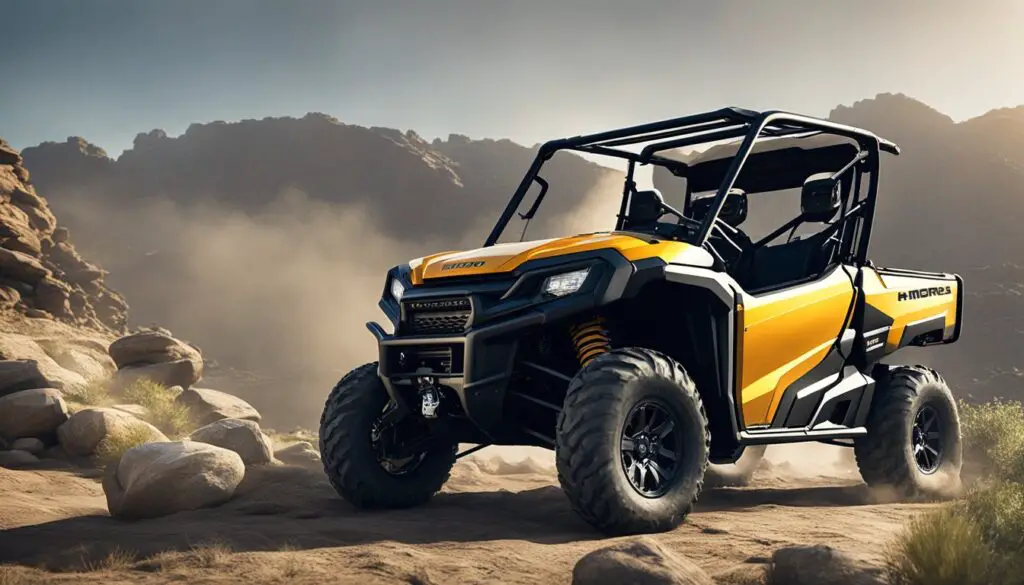
When comparing the Honda Pioneer 1000 with the Polaris Ranger 1000, you’ll notice distinct features in their ride and handling that could influence your preference. Both are engineered to provide a comfortable ride with competent handling, but the specifics of their suspension systems, control dynamics, and ability to navigate tough terrain are what set them apart.
Suspension System
The Honda Pioneer 1000 is equipped with an independent rear suspension (IRS) ensuring a smooth response to uneven terrain. It’s designed to maintain consistent ground clearance and improve overall comfort. The Polaris Ranger 1000, on the other hand, is known for its smooth ride thanks to a refined suspension system that offers significant suspension travel, absorbing bumps and ruts effortlessly.
Steering and Control
With rack and pinion steering, your control in the Pioneer 1000 is direct and reliable, especially on challenging trails. This system is coupled with a well-designed shaft drive that adds to the vehicle’s durability and strength. In contrast, the Ranger 1000 features a steering that is tuned for precision, aiding in making tighter turns with less effort, which might come in handy during off-road adventures or when maneuvering in smaller spaces.
Tires and Off-Road Performance
Both the Pioneer 1000 and Ranger 1000 come with robust tires that complement their off-road capabilities. The Pioneer generally provides good ground clearance, an essential attribute for clearing obstacles. The Polaris Ranger emphasizes its all-wheel drive (AWD) system, enhancing its off-road performance and ability to tackle various terrains with ease. This system works well with the vehicle’s designed tires, which provide grip and traction in most conditions.
Utility and Functionality

When choosing between the Honda Pioneer 1000 and the Polaris Ranger 1000, you’ll likely consider how these vehicles will perform when it comes to tasks like hauling, towing, and navigating terrain. Each vehicle offers distinct features that cater to utility and functionality, which are crucial for tasks ranging from recreational to professional use.
Fuel Efficiency and Capacity
Fuel efficiency is an essential aspect when considering a utility task vehicle (UTV). Honda’s Pioneer 1000 is known for a decent fuel economy and comes with a 7.9-gallon fuel tank. In comparison, the Polaris Ranger 1000 is equipped with a 11.5-gallon tank. This larger capacity means fewer fill-ups for you during long workdays or extended rides.
Accessories and Customizability
Accessories and customizability are where you have the room to tailor the UTV to your specific needs. With both the Honda Pioneer and Polaris Ranger, you get a vast catalog of optional extras:
- Honda Pioneer 1000: Offers a range of accessories designed for both utility and recreation, including storage solutions and protection gear.
- Polaris Ranger 1000: Comes with a comprehensive lineup of accessories, making it highly customizable for whatever task you have at hand.
Utility for Ranchers and Farmers
For ranchers and farmers, the UTV you choose becomes an extension of your toolset.
- Hunter: If you’re using the UTV for hunting, you may prioritize features like camouflage accessories, quiet operation, and off-road capability.
- Farmer & Rancher: Durability and the ability to carry heavy loads are essential. Both the Honda and Polaris offer ample bed capacity, with the Polaris Ranger 1000 providing up to 1,500 lbs of payload capacity, which is beneficial for transporting feed, tools, or harvests.
Safety and Reliability
When choosing between the Honda Pioneer 1000 and the Polaris Ranger 1000, consider how both prioritize your safety and the reliability of their features. They are designed to provide peace of mind through robust protective systems and consistent performance throughout their lifespan.

Braking System
Your Honda Pioneer 1000 comes equipped with hydraulic disc brakes at both the front and rear, which are known for their strong stopping power and responsiveness. This braking system ensures maximum control, even on rough terrains. Conversely, the Polaris Ranger 1000’s brakes are meant to offer reliable deceleration with a setup that’s built for consistent performance, giving you confidence while maneuvering.
Durability and Maintenance
Regarding the Pioneer 1000, Honda is recognized for durability and an extensive life expectancy, which means less frequent maintenance for you. Its construction is sturdy, aimed at tackling diverse environments with ease.
In the case of the Polaris Ranger 1000, the emphasis on a rugged build also speaks to its durability. If you’re looking for a UTV that can endure the strains of heavy-duty use, consider the Ranger’s design that supports reliability in the long term. Regular maintenance schedules for both of these UTVs are key to their longevity, so keeping up with them will help ensure that your vehicle remains safe and reliable throughout its use.
Pricing and Value
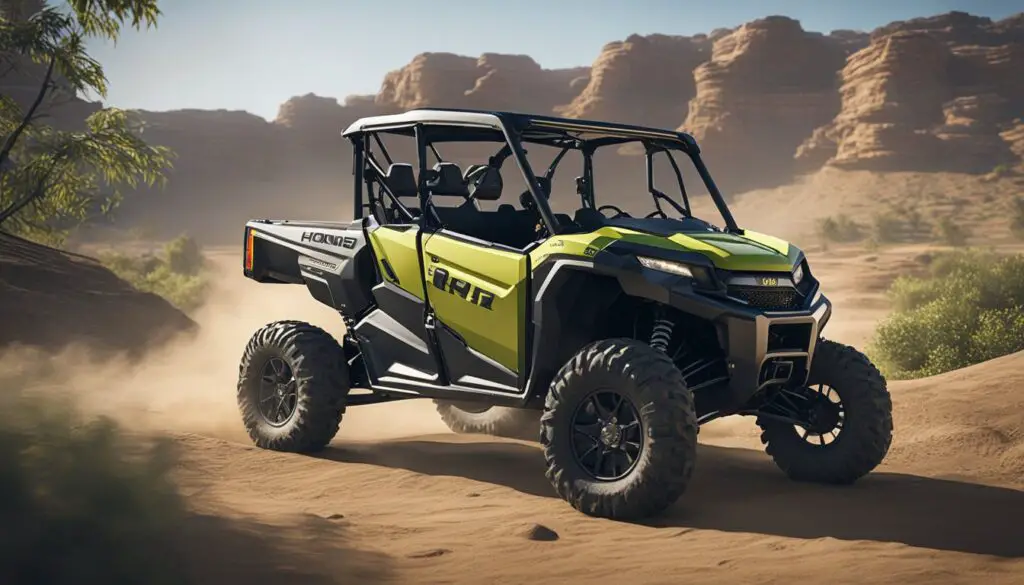
When considering the Honda Pioneer 1000 and the Polaris Ranger 1000, you’ll want to compare both the initial price and the long-term cost of ownership. These factors include upfront costs such as the MSRP and ongoing expenses like fuel consumption.
Base Pricing
The MSRP (Manufacturer’s Suggested Retail Price) for these vehicles can be a significant factor in your decision-making process. As of the latest models, the Honda Pioneer 1000 typically presents itself with a starting price that can be competitive, while the Polaris Ranger 1000 offers a similar baseline but may vary depending on the specific model and features you choose. For example:
- 2023 Honda Pioneer 1000 Trail: Starting at $20,899
- 2023 Polaris Ranger 1000 Base: Starting at $20,899
Cost of Ownership
Your long-term expenses extend beyond the initial purchase. You should consider the following:
- Fuel Consumption: Both models have engines designed for efficiency, but the actual fuel consumption may vary depending on usage patterns.
- Maintenance Costs: The Honda is known for its robust build and reliability, potentially leading to lower maintenance costs, a point often noted as a pro in ownership. On the other hand, the Polaris, while also reliable, may present different maintenance intervals or costs due to its design and parts availability.
- Pros and Cons: The Honda’s reputation for longevity can be a pro in terms of value retention, while the Polaris is often praised for its power output, providing a conundrum depending on whether you prioritize durability or performance.
Model Variations
When exploring the Honda Pioneer 1000 and Polaris Ranger 1000, you’ll discover a diverse range of models designed to cater to different needs and preferences. Take a closer look at what each lineup offers in terms of trim levels and configurations.
Trim Levels and Configurations
Honda Pioneer 1000:
You can choose from multiple Pioneer 1000 models, each with varying features:
- Standard: The base model provides a robust experience suitable for general use.
- Pioneer 1000 EPS: This version includes Electric Power Steering for enhanced handling.
- Deluxe: The Deluxe trims boast upgraded features like LED headlights and custom painted bodywork.
- 5-seater: Select models like the Pioneer 1000-5 Delux come with a convertible seating arrangement that can accommodate up to five passengers.
Honda also offers the Pioneer 700 and Pioneer 500 as part of their wider UTV range, which are scaled-down versions in terms of power and size.
Polaris Ranger 1000:
In the Ranger lineup, Polaris offers a variety of models, including:
- Ranger 1000: The basic Ranger 1000 offers a blend of performance and value.
- Ranger Crew 1000: The Crew trim highlights a larger cabin space for up to six individuals, perfect for team outings.
- XP 1000: Sitting at the top with premium features, the XP 1000 trim includes a more powerful engine and advanced technology.
- Ranger EV: For an eco-friendly option, the Ranger EV provides an electric version of the vehicle.
The Ranger model series also includes the smaller Ranger 500, giving you a mix of options depending on your needs.
Consumer Experience
When you’re deciding between the Honda Pioneer 1000 and the Polaris Ranger 1000, your experience on the trails or during work tasks is a top priority. Each model has unique features designed to maximize comfort and ease of use during operation.
Comfort Features and Conveniences
The Honda Pioneer 1000 is known for its comfortable ride quality and adaptable seating system, which comes in handy when you’re spending long hours on the vehicle. An adjustable seat slider ensures you can find the perfect driving position with ease. In terms of convenience, the Pioneer doesn’t skip on the details:
- Cupholders: Strategically placed for easy access.
- Unique Features: The Pioneer offers a versatile seating system, allowing you to adjust the cabin layout for passenger or cargo needs.
Switching gears to the Polaris Ranger 1000, the vehicle is equipped with a spacious and comfortable ProShield cab system, which seals tightly to keep out dust and water. The Polaris Ranger also offers:
- EPS: Electronic Power Steering comes standard, providing a smoother and more controlled ride.
- Comfort: Enhanced seating and an adjustable steering wheel heighten comfort for riders of all sizes.
User Reviews and Ratings
According to user feedback, the Polaris Ranger 1000 scores high marks for its smooth transmission and powerful engine. Reviewers often mention the efficiency of the Continuously Variable Transmission (CVT), which effectively transfers power to the wheels. Some of the points brought up in reviews include:
- Ease of Use: The Ranger’s CVT is frequently praised for its seamless power delivery.
- Comfort: Feedback often appreciates the comfortable seating and spacious cab.
The Honda Pioneer 1000, on the other hand, receives kudos for its fuel efficiency as well as reliability. A few standout points from reviews and ratings are:
- Adjustable Seat Slider: This feature has been mentioned as a game-changer for personal comfort.
- Ease of Use: Its user-friendly nature and versatile seating configuration are commonly highlighted.
Frequently Asked Questions
In this section, you’ll find direct answers to common questions regarding the Honda Pioneer 1000 and Polaris Ranger 1000 to help you discern their differences in performance, towing, off-road capabilities, fuel efficiency, maintenance costs, and passenger capacity.
What are the main performance differences between the Honda Pioneer 1000 and the Polaris Ranger 1000?
The Polaris Ranger 1000 boasts about 80 horsepower, slightly more than the Honda Pioneer 1000’s 72 horsepower, offering stronger acceleration and potentially better performance in demanding situations.
Which has a better towing capacity, the Honda Pioneer 1000 or the Polaris Ranger 1000?
Both UTVs are known for their robust towing capacities. Check the manufacturer’s specifications for the most current ratings to compare them directly, as they can be quite similar or vary based on the model and year.
How do the Honda Pioneer 1000 and the Polaris Ranger 1000 compare in terms of off-road capabilities?
Both vehicles are designed to tackle rough terrain. Your experience off-road may vary based on each vehicle’s specific suspension system, tire setup, and weight distribution.
Which is more fuel-efficient, the Honda Pioneer 1000 or the Polaris Ranger 1000?
The Honda Pioneer 1000 is generally considered more fuel-efficient, which could be a deciding factor if you are concerned about fuel consumption and operating costs.
In terms of maintenance costs, which is more economical over time: the Honda Pioneer 1000 or the Polaris Ranger 1000?
While maintenance costs can vary based on usage and care, typically, the Honda Pioneer 1000 is known for its reliability and may incur lower maintenance costs over time compared to the Polaris Ranger 1000.
Can the Honda Pioneer 1000 accommodate more passengers compared to the Polaris Ranger 1000?
The Honda Pioneer 1000 features a versatile seating system which may allow for different passenger configurations. You’ll want to look at specific models to see if additional seating is available, as this can vary.

